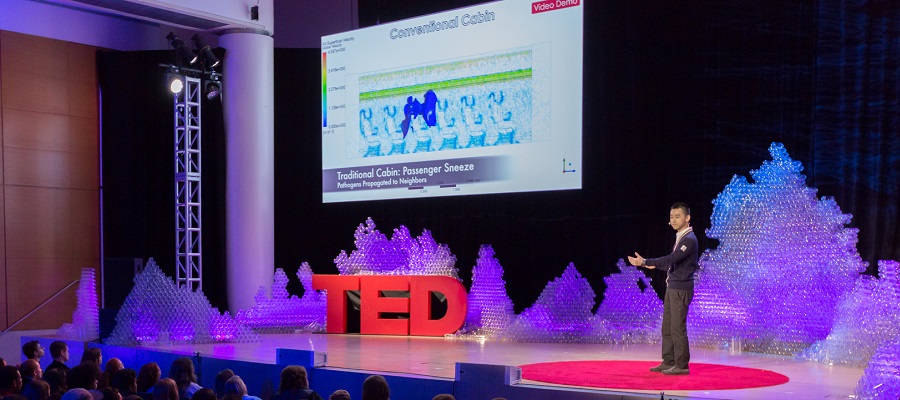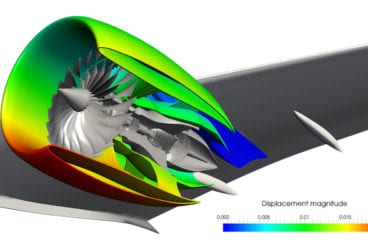Two years ago, Raymond Wang, a 17-year-old Canadian student, and aspiring CFD engineer, won the top prize at the Intel International Science and Engineering Fair (ISEF). He took home the $75,000 Gordon E. Moore Award for solving one of the biggest problems with air travel and revolutionizing air quality inside an airplane cabin.

The Engineering Problem: Airplane Cabin Air Quality
In December 2015, when the news was flooded with reports about the Ebola outbreak in West Africa, a problem immediately caught Raymond’s attention. While Ebola is not airborne, other contagious diseases—including the H1N1 flu, SARS virus and of course the common cold—are. That can be a serious problem for the passengers in the cramped confines of an airplane cabin, where everyone is breathing the same air and effectively spreading germs and infections to other passengers.
“With the traditional airplane cabin, what’s happening is you’ve got two large, turbulent swirls. You’re spreading disease across the rows and longitudinally”, says Wang. In other words, when someone sneezes on a plane, particles go flying all over the place.
This is a problem that here at SimScale we have explored as well. The simulation you see on the right was performed on the SimScale cloud-based CFD platform. Last year, Kristina—a Business Developer at SimScale—won the internal SimScalator competition for this passive scalar fluid flow simulation of sneezing in an aircraft.
Here’s How a CFD Engineer Solved This Problem
Once you understand the behavior of airflow, it is possible to find ways of manipulating it and to make well-informed decisions regarding design adjustments.
Raymond Wang used the simulation data to eventually design simple fin-shaped devices that could be integrated into the plane inlet system. By redirecting the airflow, this device would create “walls of air” around each passenger, pushing the sneeze particles out of the cabin before they spread to any of the other passengers. According to Wang, his innovative and cost-efficient design would improve the air quality in the airplane cabin by 190%, and reduce the airborne microbe concentration 55 times—all for a mere $1,000 of hardware and installation costs [1].
Software, Hardware, and Expertise – No Longer a Barrier
The invention is even more impressive considering the fact that Raymond Wang learned CFD from scratch by himself, watching tutorial videos and reading papers. The complexity of the multiphysics involved in engineering simulation has long intimidated engineers with limited expertise in numerical analysis. If some are still skeptical that computer-aided engineering (CAE) is democratizing, there is no better proof than this story. With the abundance of learning resources and simulation templates freely available, any engineer or designer can learn to leverage simulation to improve existing products or pioneer something entirely new and innovative. In particular, SimScale’s CFD Master Class is aimed at empowering CFD engineers to do just that.
Costly hardware and software required to perform CFD simulations is another barrier discouraging many design engineers from implementing their innovative ideas. Raymond Wang was lucky to get noticed for his talent and was sponsored by a major CFD software vendor, but this is not an option many can exploit. This posed a serious obstacle until cloud-based CFD platforms presented an alternative solution, granting anyone access to engineering simulation with flexible subscription-based pricing plans and remotely accessible computing power. This is how the last hurdle deterring many engineers from making use of simulation in their work was eliminated.
Getting Started with Cloud-Based Simulation
This is just one example of a multitude of real-life problems that a motivated CFD engineer can solve. Others include cooling of electronics—especially devices that need to operate under special conditions such as underwate—, ventilation systems for cleanrooms in pharmaceutical research and other activities performed under controlled environments, and aerodynamic optimization of sports devices to mention a few. The technology to solve many of the real-life problems we face is already there, all that is missing is someone dedicated enough to apply it.
Raymond Wang’s success is certainly a story any CFD engineer or determined individual (even without an engineering background) can draw inspiration from. Who hasn’t dreamed of coming up with something ground-breaking and making a real change? While a desire to make a difference may not be enough, and in order to translate a brilliant idea into practice powerful tools are often necessary, they are no longer subject to the barriers they once were. If you are someone with great ideas and are in need of a scalable, less investment-intensive tool to bring them to life, look no further.
Explore the SimScale platform by creating a free Community account.
Discover all the simulation features provided by SimScale. Download the document below.
References
- Raymond Wang Official Website, https://www.raycorpglobal.com/



